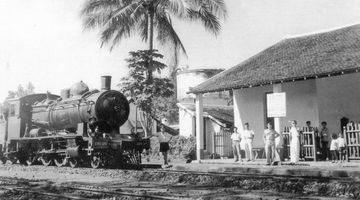Konglor and Ban Nahin Travel Guide
In a nutshell
Konglor is a small village in rural Laos that is becoming famous for its beautiful nearby cave, located in Phou Hin Phoun National Park.
Why go to Konglor
The 7.5 km of the Hinboun River running through this cave makes it one of the longest river cave systems in the world. The entire river can be traversed by motorized long boat, although during the dry season, the boat may drag in some low-water areas, forcing you to get out and walk for a bit. Alternatively, during the rainy season, you might notice some extra splashing and drips from the cave’s ceiling, so a rain jacket is recommended.
The boat ride through the cave offers stunning views of stalactites, stalagmites, large vaulted ceilings, and exhilarating twists and turns throughout the cavernous areas until finally emerging on the other side. Although this area of Laos is a bit “off-the-beaten-track” of the usual tourist areas in the country, most travellers who make the trip out to Konglor and Ban Nahin report it as one of the highlights of their travels in Laos.
Trips to the cave are not expensive, but rather than paying one flat fee at any point, you do need to be prepared for a variety of small costs popping up here and there along the way. Entrance to the national park costs LAK2,000, while entrance to the cave itself costs LAK10,000. The cost for the boat itself will vary depending on how many people are in the boat with you (each boat can hold 3 passengers), but you should expect to pay a minimum of LAK110,000 if you're traveling in the boat alone. Extra passengers will add a bit to the overall cost, but splitting will make it cheaper in the long run.
Tad Namsamam, a waterfall just a few kilometres outside the village, is another popular sightseeing stop for travellers coming through Ban Nahin. A path through the jungle leaves from the village itself, and can be easily trekked in a day as it's only about 3 kilometres away. You will need to buy a ticket for LAK15,000 from the Ban Nahin tourist office, and you will want to start your trek before noon to avoid wandering in the jungle after dark.
Where to stay
Although there are some guesthouses in Konglor, the nearby village of Ban Nahin is probably a more popular accommodation area for travellers coming to visit Konglor Cave. There are several guesthouses available in Ban Nahin, and as part of the famous “Loop” that many travellers ride around by motorbike from Thakhek, Ban Nahin is an excellent place to rest your head before launching off into a tour of Konglor Cave.
Keep in mind that Ban Nahin is just a small village, and while tourism to the cave and to this area is growing rapidly, it is still relatively new to this area – we mean, really new. As such, you won't be finding many luxury hotels or high-end resorts in or around Ban Nahin or Konglor; however, there are plenty of cheap guesthouses with basic, pleasant accommodations available.
In Konglor itself, the popular accommodation options include Konglor Eco-Lodge, Phounsouk Guesthouse, Chanta Guesthouse, and the more upscale riverside Spring River Resort. Prices are often cheaper in these places with walk-up requests, rather than reserving a room online – think LAK100,000 vs. LAK50,000! Prices at Spring River Resort range from LAK120,000-LAK250,000 for either rattan or wooden bungalows along the river. Spring River is not quite your average backpacker accommodation, but it’s not extremely fancy either. It's mainly the “little extras” here that make it feel a bit luxurious compared to the more basic accommodations.
In Ban Nahin, you'll have several more guesthouse options, and here you can expect to pay around LAK70,000-LAK100,000 for the most basic rooms in places like Vangphouthong Guesthouse or Inthapaya Guesthouse. A slightly fancier option, Sanhak Guesthouse offers private bathrooms with hot water and air conditioning in the rooms; rooms in places like this will cost you closer to LAK200,000. We really enjoyed our stay in Vangphouthong Guesthouse with a very welcoming family, a large open terrace, a tidy room and an abundance of local authentic atmosphere around. Well... Maybe, a bit too much, actually.
Where to eat in Ban Nahin
There are a few traditional Lao restaurants in Ban Nahin, and a local market that mainly sells fruit, vegetables, and fish. It’s a small village, but have a wander around and you're sure to find a spot to eat for cheap. If you want to eat somewhere that’s a bit more geared toward the Western tourist, then Moonlight restaurant is a great pizza restaurant with princes ranging from LAK40,000-LALK70,000. Dokkhoun Restaurant is another great little spot. The options aren't numerous, but don't worry, you won’t go hungry in Ban Nahin.
How to get to and from Ban Nahin
It’s easy to get to Ban Nahin by bus; buses running from Vientiane to Lak Sao will generally all stop at Ban Nahin. If you're coming from Thakhek, there are direct buses to Ban Nahin in the mornings, or you can take a bus from Tha Kharkiv to Vieng Kham (for about LAK30,000), a popular transit point into Ban Nahin, where you can then take a songthaew to Ban Nahin for about LAK20,000.
Another popular method of transport to Ban Nahin is via motorbike, usually coming from Thakhek. Ban Nahin is part of a popular motorbike itinerary among backpackers, known as the Loop, and when you rent a bike in Thakhek, you can obtain a map and detailed information about how to traverse the area. Road signs for Konglor Cave will also help you find your way to Ban Nahin.
If you don't fancy the drive from Thakhek, it is also possible to rent a motorbike in Ban Nahin itself, used primarily for navigating to the cave and surrounding areas (as the village itself is small enough to easily walk around). A motorbike rental will cost you about LAK50,000-LAK80,000 for one day. You can also take a tuk-tuk from Ban Nahin into Konglor, or a public bus that will set you back about LAK25,000.
Is Ban Nahin and Konglor a safe place to visit?
Ban Nahin and the nearby Konglor cave is a destination that is growing in popularity with both Lao tourists as well foreign travellers, and if you have the time and ability to add this spot to your Laos itinerary, you surely should try to stop by here.
Both places are quire safe, with welcoming and friendly locals. Crime against foreigners has never happened before.
The boat ride through the cave can look rather unsafe as the boats are rickety and it is absolutely dark inside the cave – the lights offered by the guides do not help much, actually. We wonder how these boats manage not to run into each other! They do give you life jackets, though. We did this trip with our 2 y.o. daughter – if you have your kids in tow, bring life jackets for them, too, as there are only adult sizes on offer there.




























